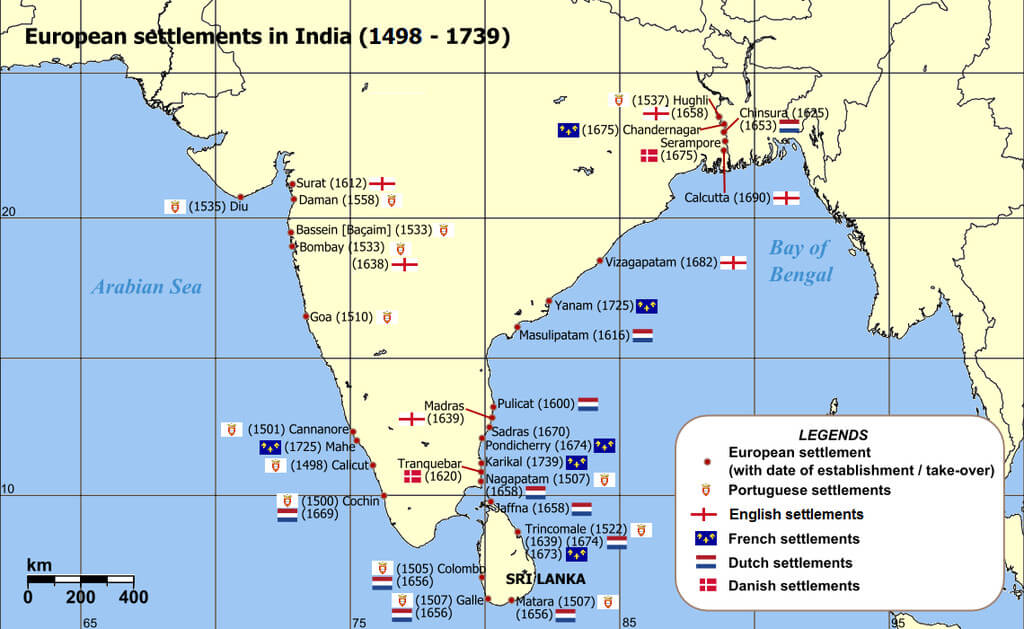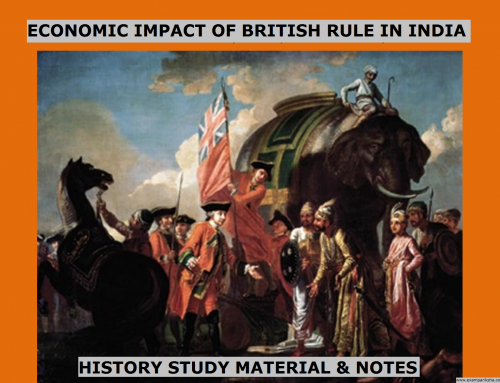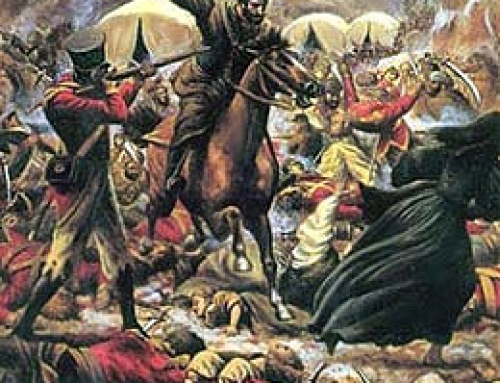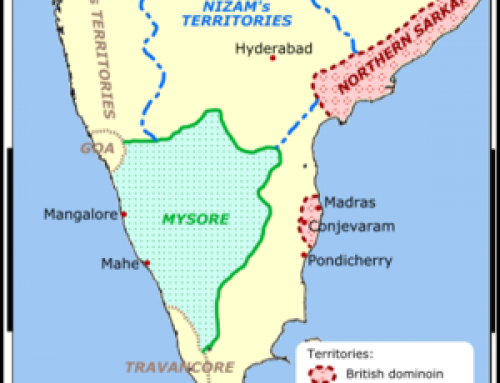The Europeans and Indians commercial contact has a long history. But it was in the end of fifteenth century, that India began to be seen as an attractive destination by the Europeans. Initially these trading Europeans only had commercial interests but by passage of time they indulged in the political affairs. Finally they established colonies here, which also led to rivalry among European powers, initially for commercial gains and later for political gains. Ultimately, the British established their rule in India.
There were five European companies which established their trading centres at various locations in coastal India. Let us look into the details.
| European Company Name | Headquarter in India | Founded in Year |
| Portuguese East India Company | Cochin, later Goa | 1498 |
| English East India Company | Surat(1st), later BombayMasulipattnam, later Madras and finally Calcutta | 1600 |
| Dutch East India Company | Pulicat, later NagapattinamHugli | 1602 |
| Danish East India Company | Tranquebar, later Serampore in Bengal | 1616 |
| French East India Company | Surat, later Pondicherry | 1664 |
Portuguese
Vasco Da Gama found the Cape of Good Hope route from Europe to India and reached Calicut in 1498. He was received by the Hindu ruler of Calicut Zamorin. Portuguese established trading stations at Calicut, Cannanore and Cochin. Initially, Cochin was the capital of Portuguese in India, but later Goa replaced it.
Francisco de Almeida was first governor of Portuguese in India. He is credited for introduction of policy of Blue Water.
Alfonso d’ Albuquerque became the second governor of Portuguese in India in 1509. He introduced policy of Imperialism. In 1510, he captured Goa from the ruler of Bijapur. Since then, Goa became the capital of Portuguese settlements in India. Albuquerque built a fort at Cochin. He also encouraged the people of his country to marry Indian women. He also captured Malacca and Ceylon.
Martin Alfonso de Souza became Portuguese governor in 1542. Along with him, the famous Jesuit Saint Fransisco Xavier arrived in India. By that time, they had captured Diu and Bassein.
Portuguese power began to decline by end of 16th century. In 1631, Hugli was lost to Mughal noble of Shahjahan. In 1661, Bombay was given in dowry to Charles II of England by the then Portuguese king upon his sisters marriage to English royal. In 1739, Marathas captured Bassein.
Portuguese were later left with just Goa, Diu and Daman which they retained till 1961.
Dutch
the Dutch East India Company was formed in 1602. They set up settlements at Masulipattanam, Pulicat, Surat, Karaikal, Nagapattinam, Chinsura, Kasimbazar, Baranagore, Patna, Balasore and Cochin.
In the 17th century, they defeated Portuguese and replaced portuguese as the most dominant power in European trade in the East, including India. Pulicat was their main centre, later it was replaced by Nagapattinam.
After middle of 17th century, English began to emerge as colonial power. Anglo-Dutch rivalry lasted for 7 decades and led to defeat of Dutch in 1759 in the Battle of Bedara.
English
Withe the advent of Europeans in India, the English did not want to be left behind. The English East India Company was established in 1600. Captain William Hawkins arrived at the royal court of Jahangir to seek permission to open factory at Surat. In 1612 Jahangir issued a Farman permitting the set up of factory at Surat.
Sir Thomas Roe arrived in India as ambassador of James I to Jahangir’s court in 1615 to seek permission for establishment of trading centres in different parts of the country. By 1619, factories at Agra, Allahabad, Baroda and Broach were set up. The company acquired Bombay from Charles II on lease.
Francis Day founded Madras in 1639 where Fort St.George was built. In 1690, Job Charnock established a factory at Sutanati. Zamindari of three villages, Sutanati, Kalikata and Gobindpur was acquired by English in 1698. Later it developed into the city of Calcutta, where Fort William was built. Calcutta became the capital of British India later. The English East India Company continued its existence till 1858.
Danish
With the coming of Europeans in India, the Netherlands also took part in trading activities. The danish settlement at Tranquebar(now known as Tharangambadi in TN) in 1620. Another important Denmark settlement in India was Serampore in Bengal, which served as their headquarter in India. The English purchased all their settlements in India in 1845.
French
The French East India Company was formed in 1664 by Colbert. First factory was established at Surat by Francois Martin in 1668. Another factory was setup at Masulipatanam. In 1673, Pondicherry was founded by Francois Martin, he was the first governor of the French headquarters in India. Other french factories in India were at Mahe, Karaikal and Chandranagore.

Anglo- French Conflict (Carnatic Wars)
The downfall of Mughal empire led to political turmoil in India. the Deccan region gained independence from Mughal empire under Nizam-ul-Malik. The Carnatic region came under Nizam’s dominion.
Of the three Carnatic wars, the second war was triggered by domestic reasons. First and Third war was influenced by events in Europe.
First Carnatic war/ Anglo-French War (1746-1748):
In 1740, with break out of Austrian War of Succession in Europe, England and France became rivals. The French besieged Madras. They defeated the army of Carnatic Nawab at St. Thomas battle under French governor Dupleix. When the Austrian Succession War was concluded withe Treaty of Aix-la-Chapelle in 1748, the first anglo-french war also came to an end.
Second Anglo-French War/ Carnatic War (1749-54)
The French Governor of Pondicherry, Dupleix aligned with Muzaffar Jung of Hyderabad and Chanda Sahib of Arcot, supporting their claim for throne. After initial gains by French, the English won a decisive victory under Robert Clive. The 2nd Carnatic war concluded in Treaty of Pondicherry also known as Treaty of Godeheau(new French Governor who replaced Dupleix) in 1754.
Third Carnatic war/ Anglo-French War (1758-1763):
The outbreak of the Seven Years War(1756-1763) in Europe led to 3rd Carnatic War. The French troops under Count de Lally captured Fort St. David. The English dfeated them at Wandiwash in 1760. English captured and destroyed Pondicherry. When Seven Year war came to an end in Europe by Treaty of Paris in 1763, the third Carnatic War also ended. The French were restricted to Pondicherry, Karaikkal, Mahe and Yenam.
<< Read about Special Drawing Rights (SDR) here>>
<< Click here for Jainism in Indian History >>
<< Read about Lok Sabha and Rajya Sabha role and functions here>>





